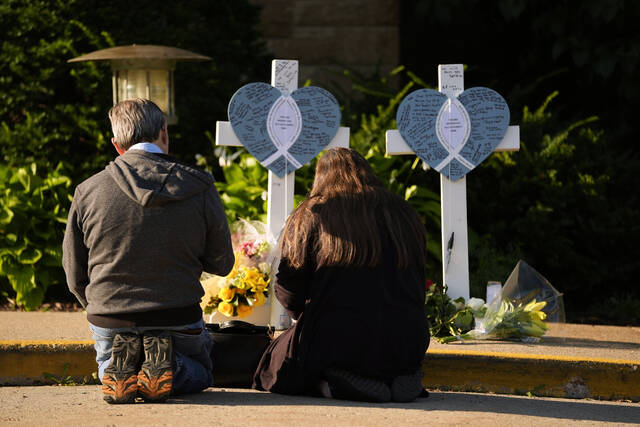https://triblive.com/opinion/lori-falce-26-years-of-thoughts-and-prayers/
Lori Falce: 26 years of thoughts and prayers

My head is full of thoughts. My soul is full of prayers.
And my heart is filled with rage, a red-hot glowing anger that, once again, children have been shot and killed.
In Minneapolis, Robin Westman, 23, armed with a handgun, rifle and shotgun, fired into the church where children from Annunciation Catholic School were at worship during the first week of school. Two children died. A total of 18 people, 15 of them students, were injured.
And the response is to offer thoughts and prayers.
Thoughts and prayers only fuel my rage because they are as disingenuous as they are useless. They are like cheap, unsigned sympathy cards tossed out because they are expected. They are like a flag pin worn by a politician who doesn’t uphold the ideals of the flag but knows it will be noted if it is not prominently featured on a lapel.
Thoughts and prayers have been pouring down like rain for decades. We are drowning in them because the fatal shooting of our children at schools doesn’t stop.
My husband went to Serra Catholic High School in December 1989 when junior Robert Butler, 16, shot another student and then himself on the bus. It was a devastating moment, but it was also unexpected. While shootings at schools have a history that dates to the early 1800s, they were usually small numbers, personally motivated and often nonfatal.
That began to change in the 1960s with the University of Texas clock tower shooting that killed 18 and wounded 31. Higher numbers popped up more frequently. In January 1989, six children were killed and 32 more injured at an elementary school in Stockton, Calif., but the gunman had a history of crime and violence. It seemed more of a continuation of his pattern than a problem in schools.
In the 1990s, things seemed to revert to form — until they didn’t. Until Pearl, Miss., in 1997, when three people died and seven were injured. Until an eighth grade dance at Parker Middle School in Edinboro in 1998 when one teacher was killed and three people were injured. A month later, four people were killed and 25 injured at a high school in Springfield, Ore.
And in April 1999, school shootings in America were redefined in a blaze of bullets in Columbine, Colo. The town’s name is now synonymous with the crime. Its death toll of 16, with 23 injuries stood as the deadliest high school shooting for 19 years. The Parkland, Fla., shooting would eclipse it with 17 deaths in 2018.
A floodgate was opened that thoughts and prayers could not dam.
School shootings now are a sickeningly commonplace reality. They have a season, like hurricanes and hunting. They happen at colleges like Virginia Tech and in one-room Amish schoolhouses like West Nickel Mines. They are as unpredictable as a tornado but as reliable as sunrise. You do not know where they will occur, only that they will.
Yet we do nothing more than offer thoughts and prayers. The failure stains and harms us all.
While one side advocates for gun control, the other pushes for mental health solutions. Both are at fault. Republicans may point the finger at mental health, but they have done nothing to fix it and indeed have taken actions to undermine treatment. Democrats know substantive gun control will not pass but do not look for other options.
It has been 26 years since Columbine. It has been more than a quarter-century of thoughts and prayers uncoupled from action. We have not allowed this with anything else. Imagine responding to cyber crime or designer drugs with good wishes instead of good government.
If we are OK with our children dying in a church during the first week of school — or in a first grade classroom as they try to hide or in the hallway of a high school as they run for their lives — we should say so.
If we aren’t, we should do something.
Copyright ©2025— Trib Total Media, LLC (TribLIVE.com)
